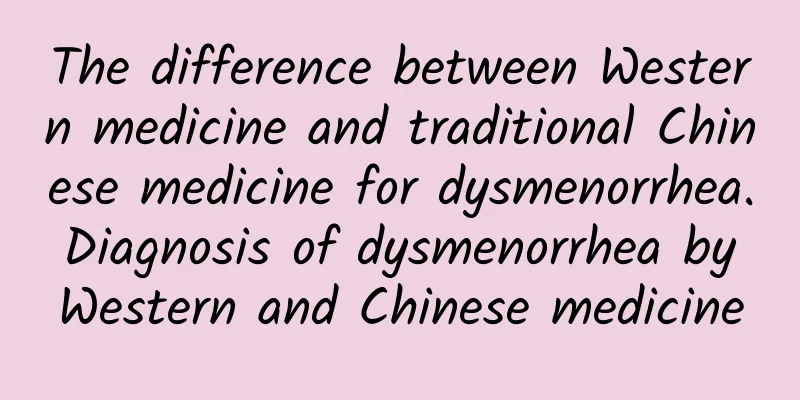The difference between Western medicine and traditional Chinese medicine for dysmenorrhea. Diagnosis of dysmenorrhea by Western and Chinese medicine

|
How to see dysmenorrhea? Differences between Western medicine and traditional Chinese medicine. Diagnosis of dysmenorrhea in both Chinese and Western medicine Dysmenorrhea is one of the common problems many women experience during menstruation. Whenever menstruation comes, some women may experience abdominal pain, back pain, and other uncomfortable symptoms, and some may even be unable to work and study normally due to dysmenorrhea. In order to find a suitable treatment plan, many women will choose to see Western medicine and traditional Chinese medicine institutions. So, how do you see the difference between Western medicine and traditional Chinese medicine for dysmenorrhea? This article will introduce you to the differences in the diagnosis methods and treatment plans of dysmenorrhea in Western medicine and traditional Chinese medicine. 1. Western medicine diagnosis In Western medicine, the doctor will ask about the patient's medical and family history in detail, conduct a comprehensive physical examination, and may perform relevant laboratory tests. Western medicine mainly diagnoses dysmenorrhea by excluding other possible causes, such as endometriosis, uterine fibroids, or ovarian cysts. 1. Endometriosis Endometriosis is a common cause of dysmenorrhea. Western medicine usually diagnoses the disease by performing an abdominal or pelvic ultrasound and taking a medical history. If ectopic endometrium is suspected, the doctor may recommend laparoscopy to confirm the diagnosis. 2. Uterine fibroids Uterine fibroids are also one of the causes of dysmenorrhea. Western medicine usually uses ultrasound examination to determine the location, size and number of uterine fibroids. Depending on the condition of the lesion, the doctor may take surgery, drug treatment or other appropriate methods. 2. TCM Diagnosis In traditional Chinese medicine, dysmenorrhea is considered a manifestation of qi stagnation and blood stasis. Traditional Chinese medicine advocates adjusting the functions of internal organs and promoting the smooth flow of qi and blood to achieve therapeutic effects. 1. Qi stagnation and blood stasis Qi stagnation and blood stasis is one of the basic concepts in TCM diagnosis. TCM believes that dysmenorrhea is caused by ovarian dysfunction, which leads to poor circulation of Qi and blood, resulting in symptoms such as abdominal pain during menstruation. TCM physicians use the four diagnostic methods of observation, auscultation, questioning, and palpation to determine the degree of Qi stagnation and blood stasis according to the patient's specific situation. 2. Massage and Chinese medicine treatment Based on the diagnosis, the TCM physician may prescribe appropriate Chinese medicine prescriptions to regulate Qi and blood, and to activate blood circulation and remove blood stasis. In addition, massage is also widely used to treat dysmenorrhea. By adjusting the acupuncture points on the abdomen and waist, massage helps improve menstrual blood circulation and relieve dysmenorrhea symptoms. There are many differences between Western medicine and traditional Chinese medicine in terms of how to view dysmenorrhea, but in general, Western medicine diagnosis mainly relies on laboratory tests and physical examinations to determine the cause of the disease, while traditional Chinese medicine focuses more on judging the patient's physical constitution and pathological condition through the four examinations in order to provide personalized treatment plans. Western medicine and traditional Chinese medicine have different methods and concepts in the diagnosis and treatment of dysmenorrhea. Western medicine mainly determines the cause of dysmenorrhea by excluding other potential causes, while traditional Chinese medicine treats dysmenorrhea by observing the patient's constitution as a whole and adjusting the flow of qi and blood. The combined application of Western and traditional Chinese medicine methods can provide a more comprehensive understanding of the cause of dysmenorrhea and achieve better treatment results. No matter which treatment method is chosen, it should be carried out under the guidance of a professional doctor and regular follow-up visits should be made to ensure the treatment effect. |
<<: How can yoga during dysmenorrhea quickly discharge blood stasis? Can yoga relieve dysmenorrhea?
>>: Which department or clinic should I go to for abortion? Does abortion require family signature?
Recommend
What causes ectopic pregnancy?
Ectopic pregnancy is extremely harmful to women. ...
How much does it cost to induce abortion in Shenzhen
How much does it cost to induce abortion in Shenz...
What are the precautions for chronic cervicitis in daily life?
Chronic cervicitis may be the result of the evolu...
Revelation from Olympic medals! Sarcopenia cannot be ignored
Weightlifting is one of the few sports in Taiwan ...
How difficult is intermittent fasting? Don't do the hardest thing now
(Author: Mike Moseley, Mimi Spencer) When should ...
I have had stomach pain for a few days before my period. Why haven't I had my period yet?
It can be confusing to have abdominal pain for a ...
4 fat burning superstars! Two-week rapid weight loss tips
June is the graduation season and also the peak w...
How to take care of women after menopause
Women need to adjust their healthy lifestyle afte...
These 3 symptoms indicate that menstruation will come soon.
Due to the influence of hormones before menstruat...
Know the symptoms of pelvic inflammatory disease
Pelvic inflammatory disease is mainly divided int...
What are the treatments for delayed menstruation? What are the dietary taboos for delayed menstruation?
There are many reasons for delayed menstruation, ...
Can coffee help people who stay up late to stay awake and relieve headaches? Nutritionist Chen Bojun: Overdosage may cause withdrawal headaches
People who stay up late have their brains still b...
Will cervicitis affect fertility? How should women who are diagnosed with cervicitis be treated?
The female uterus is an important reproductive or...
Two common causes of cervical erosion
Cervical erosion is a relatively common gynecolog...
Symptoms of acute pelvic inflammatory disease
Pelvic inflammatory disease is a type of gynecolo...









